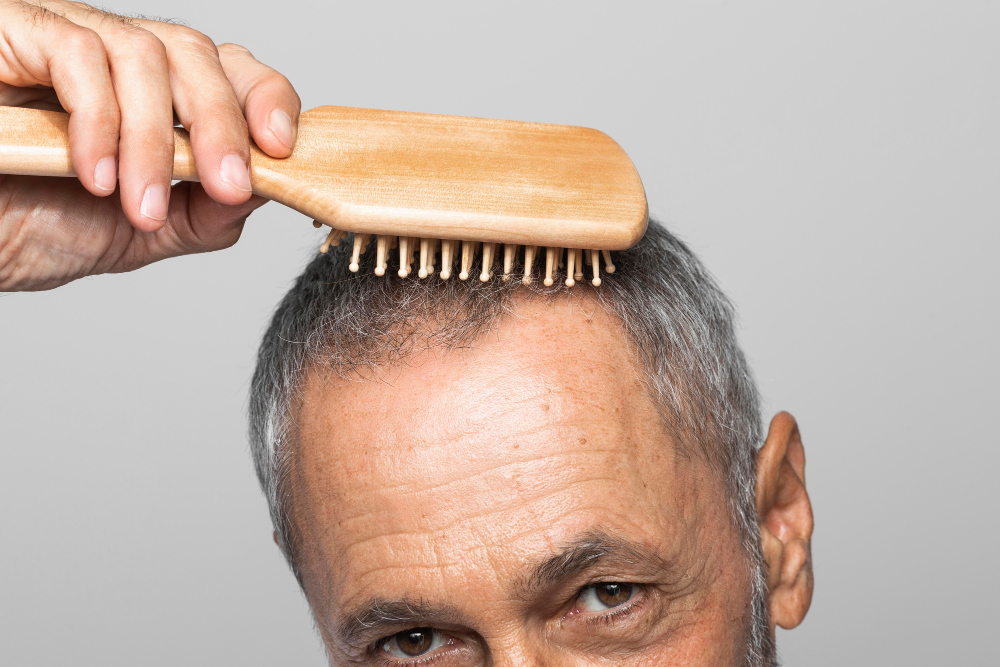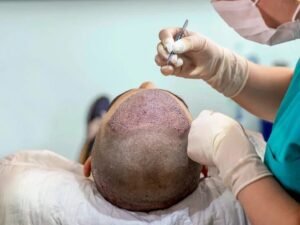Our hairline is one of the most defining features of our face, contributing greatly to how confident we feel about our appearance. A full, youthful hairline is often seen as a symbol of vitality and attractiveness — so when it starts changing, many people worry that it could be the start of hair loss or baldness.
However, not every change in your hairline is a sign of trouble. Hairlines naturally evolve with age, and mild recession is often part of a completely normal process. The challenge lies in knowing whether what you’re experiencing is a mature hairline or an early stage of a receding hairline.
In this guide, we’ll help you understand the difference, identify the signs, and know when it’s time to take action.
Understanding Your Hairline
As the years pass, your hairline naturally changes. You might notice that your forehead looks slightly broader, or that some hair sheds while styling. These changes can feel concerning, but understanding what’s normal versus what’s not is the key to maintaining peace of mind — and healthy hair.
What Is a Mature Hairline?
When you’re in your teens or early twenties, your hairline is in what’s called a juvenile phase — low, rounded, and dense. Over time, hormonal changes and the natural ageing process cause the hairline to move slightly upward, creating what’s known as a mature hairline.
This transition typically happens between ages 25 and 30, and it’s completely natural. Your hairline may take on a subtle M-shape or V-shape (sometimes referred to as a widow’s peak). You may notice mild thinning near the temples, but it stabilizes over time and doesn’t continue to recede.
In short, a mature hairline is simply a sign of growing older — not of going bald.
What Is a Receding Hairline?
A receding hairline, on the other hand, is a sign of progressive hair loss — most often due to androgenetic alopecia (pattern baldness). This condition is driven by the hormone DHT (dihydrotestosterone), which causes hair follicles to shrink over time, leading to thinner, weaker strands and eventual hair loss.
Unlike a mature hairline that stabilizes, a receding hairline continues to move backward, often forming a deeper “M” or “U” shape with uneven thinning. It usually starts at the temples and forehead, and without treatment, can spread to other areas of the scalp.
Both men and women can experience a receding hairline, though it’s more common in men.
Why Your Hairline Might Be Changing
There are several factors that can cause or accelerate hairline changes — some temporary, others more persistent:
- Genetics: Family history plays a major role. If close relatives have experienced baldness, your risk is higher.
- Hormones: High levels of DHT can weaken hair follicles over time.
- Stress: Chronic stress can trigger a condition called telogen effluvium, which causes sudden shedding.
- Age: Natural ageing causes follicles to produce thinner hair and shift the hairline slightly backward.
- Hairstyling Habits: Tight hairstyles like ponytails or buns can cause traction alopecia, leading to thinning around the front.
- Nutrition: Poor diet or lack of key nutrients such as protein, iron, and vitamins A & D can contribute to hair loss.
How to Tell if Your Hairline Is Receding
If you’re unsure whether your hairline is maturing or truly receding, here are three simple factors to assess:
- Age:
- Hairline changes before age 25 could indicate early hair loss.
- Mild shifts between 25–30 are usually just natural maturation.
- Hairline changes before age 25 could indicate early hair loss.
- Pattern:
- A mature hairline moves back evenly.
- A receding hairline looks uneven or patchy, with visible thinning around temples.
- A mature hairline moves back evenly.
- Progression:
- A mature hairline stabilizes after a few years.
- A receding hairline continues to move back over time.
- A mature hairline stabilizes after a few years.
If you notice continuous hair loss or visible scalp exposure, it’s time to speak to a hair restoration expert for evaluation.
Treatment & Management Options
If it turns out your hairline is receding, don’t worry — there are effective, non-surgical and surgical options to slow, stop, and even reverse the process.
Non-Surgical Options
- Topical and Oral Medications: Treatments like Minoxidil and Finasteride can help slow down DHT effects and stimulate regrowth.
- Laser Therapy (LLLT): Low-level laser therapy helps improve blood circulation in the scalp, encouraging follicle activity.
- Lifestyle Adjustments:
- Eat a balanced diet rich in protein and leafy greens.
- Reduce stress through meditation, yoga, or regular exercise.
- Avoid tight hairstyles and harsh chemical treatments.
- Eat a balanced diet rich in protein and leafy greens.
Surgical Options
If your hair loss is more advanced, a hair transplant may be the most effective long-term solution.
One of the most trusted modern techniques is FUE (Follicular Unit Extraction) — a minimally invasive procedure that transplants healthy hair follicles from the back of the scalp to the thinning areas. The results look completely natural and recovery time is minimal, often within two weeks.
When to Seek Professional Advice
If you’ve noticed your hairline changing and you’re unsure whether it’s natural or something more, consult a specialist. Early intervention is key — the sooner you start treatment, the better your chances of preserving and restoring your hair.
Restore Your Confidence with Skin & Sculpt
At Skin & Sculpt, we understand that hair loss isn’t just about appearance — it’s about confidence and self-image. Our experts specialize in advanced hair restoration treatments, including modern FUE hair transplants and non-surgical solutions tailored to your individual needs.
Whether you’re dealing with a mature hairline or progressive thinning, our team will guide you through safe, effective options to help you achieve a fuller, healthier hairline — and feel your best again.
Meet Our Experts at Skin & Sculpt
Dr. Neetika Paul — Aesthetic Dermatologist, Co-Founder, Skin & Sculpt Clinic
Expert in skin rejuvenation, anti-aging, acne, pigmentation, laser treatments, and non-surgical aesthetic procedures. Based in Chandigarh, trusted by celebrities and high-profile clients.
Dr. Himanshu Paul — Hair Transplant & Facial Cosmetic Surgery Specialist
Expert in FUE Hair Transplant, Aesthetic Rhinoplasty, and reconstructive cosmetic surgery. MBBS (JNMC, Aligarh Muslim University) and MS (General Surgery, PGI Rohtak).
Book your consultation with Skin & Sculpt today and take the first step toward reclaiming your confidence.
Contact Skin & Sculpt
Clinic Address:
First Floor, SCO 84-85, Madhya Marg, Sector 8C, Sector 8, Chandigarh, 160009
General Enquiries:
support@skinandsculpt.com
+91 7696816291




